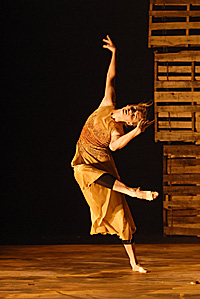Seattle choreographer Donald Byrd confronts the Israeli/Palestinian struggle in A Chekhovian Resolution, which debuts November 21 and 22 at the Moore Theatre. Co-commissioned by Seattle Theatre Group, the work is a collaboration between Spectrum Dance Theatre’s Artistic Director Byrd, the Israeli choreographers Nir Ben Gal and Liat Dror, and the Palestinian Arab composer/musician Wissam Murad.
The title comes from Israeli author Amos Oz’s view of the Israel/Palestine story in terms of literary tragedy: Shakespeare’s tragedies end with “the stage strewn with dead bodies, and maybe there’s some justice hovering above,” while Chekhov’s tragedies end with “everybody disillusioned, embittered, heartbroken, disappointed, absolutely shattered, but still alive. And,” Oz concluded, “I want a Chekhovian resolution.”
The piece is not political, Byrd declares on his video blog (www.spectrumdance.org). “It’s about how do people negotiate relationships. You don’t translate the Palestinian/Israeli conflict into a dance. You’re gonna make a little dance about it?”
“Little” is the opposite of Byrd’s ambitious plans. A Chekhovian Resolution is the inaugural work in Spectrum’s three-year initiative called “Beyond Dance: Promoting Awareness and Mutual Understanding.” Byrd’s intention may not be “political” in the traditional sense, but his vision for this project is “to radically and authentically use the medium of dance to promote better local and global understanding.”
“Artists are stand-ins for the public, they’re people who are willing to explore, have their process exposed to the public,” Byrd asserts.
In this piece, not only the artists, but the floor itself stands in for something: The land. Dancers bang on it, stretch across it, push each other over it, argue at tables about it. At Spectrum’s Madrona-area rehearsal space last week, Ben Gal, watching at the edge of that floor, stood in for the audience, which will be seated in a U-shape at the Moore, an arrangement billed as “staged for intimate viewing.” Above the din of a dozen bodies, Byrd himself intones a recitation of centuries of claims to the land.
He hadn’t even been to that land when he first got the idea to do this piece.
“I wanted to go because I didn’t know,” he says. After spending nine days in Israel this past August, he concluded that the struggle is much more complicated than he had realized from here. “Nothing was like what I expected.
“I recognize that people on both sides are suffering. Is it ethnic? Moral? Security? People don’t know what to do, so they are in pain.”
With his art, Byrd says, “I hope to be a compass to both sides.”
Byrd spent three days in Tel Aviv and most of the rest of his time in Jerusalem. He also went south, aware that he wanted to collaborate with Ben Gal and Dror, whose work came to his attention through an Internet search. Partners in marriage as well as in art, the two created an award-winning international touring dance company, launched in 1985 in Tel Aviv. But a decade ago they moved to a place near Mitzpe Ramon, in the Negev Desert. There, they run a combination hostel, campground, retreat and dance center, called Adama — earth.
They are raising their four children there. Both are sabras, born on kibbutzim: Nir at Rosh Hanikra, Liat at Lochamei HaGetaot.
To find a Palestinian musical collaborator, Byrd and Ben Gal went to East Jerusalem to meet Said Murad, a composer and director of the Palestinian music group Sabreen, whose name was suggested by the U.S. Consulate in Jerusalem. Murad’s brother, Wissam, turned out to be just the artist Byrd and Ben Gal had in mind.
Wissam Murad had collaborated with Israeli rock star David Broza on a groundbreaking bilingual recording, Belibi/In My Heart. (Their video, with translation, is on YouTube).
Murad will add a percussion ensemble to his voice and oud. Unlike some choreography — Balanchine’s, say, or Mark Morris’s — in which movement matches music, A Chekhovian Resolution is being developed independently of the music. The musicians will meet the piece and fine-tune that relationship when they arrive. As of this writing, they were still awaiting visas from the U.S. embassy in Israel.
Finding a Palestinian musician willing to collaborate with Israelis was no small task. As Ben Gal points out, Palestinian artists tend toward the political right; Israeli artists tend toward the left. He says Israeli artists are clamoring for opportunities to work with Palestinians, but, all too often, Palestinian artists refuse to work with Israelis at all.
Several musicians Byrd and Ben Gal were interested in turned them down, sight unseen, for that reason, including the celebrated violinist and oud virtuoso Simon Shaheen, who played in Seattle in the University of Washington’s World Series last season.
“Not to perform together is to keep the issues invisible,” Ben Gal laments. “To collaborate makes the issues visible.”
And what are the issues? “Here we have this dance. Is it mine? His? The dancers’?” says Byrd. “Every problem in the world has “˜this is mine’ at the root of it. I need to learn to surrender, and I don’t surrender so easily. I learn it from Nir.”
Ben Gal and Dror decline to perform in Israeli locations beyond the Green Line. Ben Gal is 50. Dror is 48. Both have done army service in the IDF. The experience went in deep.
“Every time Donald says “˜Israel’ or “˜Palestine,’ my body goes like this,” says Ben Gal, tightening. “When Donald talks about humiliation of the body, every day we deal with this. It’s not an easy experience. But it is an amazing experience.”
“One of the things that drew me to Nir was that he’s kind and generous, and Lior is very compassionate, a Mother Earth,” says Byrd. “Their impact on my work may not be so much in this dance but in the next one, and the ones after that.”
“I feel it is Donald’s story,” Ben Gal responds. “How he sees the Israeli/Palestinian situation from far away, looking from the outside.”
A not-so-little dance
